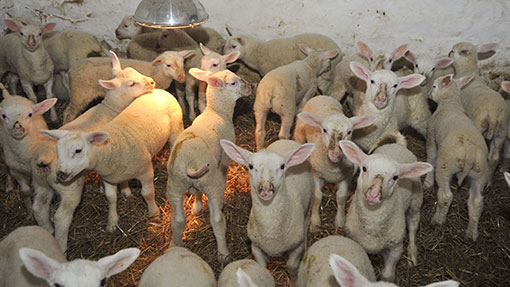Practical tips to prevent lamb hypothermia

The weather may be out of your control, but there are steps you can be taking to reduce losses from hypothermia in your flock.
The hypothermic lamb is familiar to anyone who has spent time with sheep.
They can be frustrating to treat, as the lamb can die for no readily apparent reason, sometimes even after intensive treatment
In an ideal situation, a stress-free birth results in a healthy lamb of an adequate size, born to healthy ewes with plenty of colostrum and milk.
If all these factors are present, then the lamb will have enough energy reserves to maintain normal body temperature for about five hours.
However, once the lamb has exhausted these reserves, if no other energy source is available, hypothermia will rapidly occur and result in the lamb’s death.
The chances of hypothermia (and successful treatment) will depend upon:
1. Lamb size
A lamb needs to be the “right size”. This varies between breeds, but 3.5-5kg for fat lamb crosses is about right. Too small and they lose heat rapidly; too large a lamb will result in a potentially difficult birth and they may not be able to suckle properly.
2. Lamb development and brown fat
The last six weeks of pregnancy, is the time of most rapid lamb growth and is when the brown fat is laid down around the lamb’s heart and kidneys.
This brown fat is the only energy source for the newborn animal and will keep the lamb alive and vigorous for about five hours after birth. In normal conditions, this is enough time to allow the lamb to dry off and start to suckle.
Once suckling properly, the colostrum takes over as the main source of energy.
3. Ewe nutrition
The last six weeks of pregnancy is also the period when the ewe’s udder develops. Ewe feeding in this period is crucial as a healthy udder, producing adequate colostrum and sufficient milk, determines how well the lamb will survive.
Signs of hypothermia in lambs
- Weak
- Hollow-flanked
- Lowered head
- Have poor suck reflex
- Slowly following or not following the ewe
- Lying down
- Coma and ultimately death
Intraperitoneal glucose
Once a lamb has used all its reserves, it is at great risk of fitting (the typical appearance of the head stretched over the back) and suffering permanent brain damage.
If it is cold, the brain is protected; so warming first can make matters worse.
Injecting glucose, provides enough energy for the brain until a stomach-tube feed can be given.
Give 50ml of warm 20% glucose solution (dilute commercial injection 50:50 with warm water). The injection site is 1in to either side of the navel and an 1in down. Insert at 45deg and inject smoothly.
The benefit of this potentially life-saving technique outweighs the small risk of damage to the internal organs or infection by using water from a kettle to dilute the glucose.
Postmortem examination
Dead lambs may well be demoralising to look at, but they are also an excellent source of information for your vet.
The examination is best done on a group of lambs and will include looking to see if the lamb has fed and what its brown fat status is.
This can then be used to alter any management techniques, such as tubing all lambs with colostrum within six hours of birth.
When treating hypothermia, the first thing to do is check the lamb’s temperature:
- 39-40C (102-104F) is normal
- 37-39C (99-102F) is mildly hypothermic
- Below 37C (≤99F) is severely hypothermic
Second, estimate the lamb’s age – either younger or older than five hours. Treatment for hypothermia depends on the temperature and age of the lamb.
Moderate hypothermia (37-39C)
- Vigorously dry the lamb with a towel
- Give warm colostrum, 50-100ml every two hours
- Warm the lamb under a heat lamp in a sheltered pen
- Return to the ewe and keep under close observation
Severe hypothermia (less than 37C, less than five hours old)
- Dry the lamb thoroughly
- Heat up rapidly using a warming box with hot air (37-40C)
- Give colostrum when the rectal temperature has come up to 37C
- Continue warming to 39C
- Return lamb to ewe and keep under close observation.
Severe hypothermia (less than 37C, more than five hours old)
- Dry the lamb thoroughly
- Give intraperitoneal glucose
- Heat up rapidly by using a warming box with hot air (37-40C)
- Give colostrum when the rectal temperature has come up to 37C
- Continue warming to 39C
